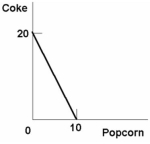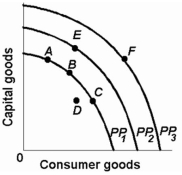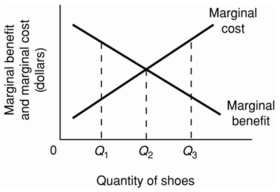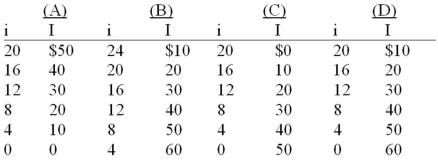A) The real domestic output increased by 2.5 percent last year.
B) Unemployment was 8.3 percent of the labour force last year.
C) The price of personal computers declined last year.
D) The general price level increased by 4 percent last year.
Correct Answer

verified
Correct Answer
verified
Multiple Choice
The typical production possibilities curve is:
A) an upward sloping line which is concave to the origin.
B) a downward sloping line which is convex to the origin.
C) a downward sloping line which is concave to the origin.
D) a straight upward sloping line.
Correct Answer

verified
Correct Answer
verified
Multiple Choice
A "hypothesis" is:
A) a fundamental truth which all economists accept.
B) a tentative, untested principle.
C) the same as a normative statement.
D) always the result of induction.
Correct Answer

verified
Correct Answer
verified
Multiple Choice
Refer to the diagram below, suppose you have a money income of $10 all of which you spend on Coke and boxes of popcorn. The prices of Coke and popcorn respectively are: 
A) $.50 and $1.00.
B) $1.00 and $.50.
C) $1.00 and $2.00.
D) $.40 and $.50.
Correct Answer

verified
Correct Answer
verified
Multiple Choice
The production possibilities curve below shows the hypothetical relationship between the production of capital goods and consumer goods in an economy.
 -Refer to the above table. What is the total opportunity cost of producing two units of capital goods?
-Refer to the above table. What is the total opportunity cost of producing two units of capital goods?
A) 4 units of consumer goods
B) 5 units of consumer goods
C) 9 units of consumer goods
D) 13 units of consumer goods
Correct Answer

verified
Correct Answer
verified
True/False
The fact that economic generalizations are abstract renders them impractical and useless.
Correct Answer

verified
Correct Answer
verified
Multiple Choice
Which of the following will not require an outward shift of the production possibilities curve?
A) an upgrading of the quality of a nation's human resources
B) the reduction of unemployment
C) an increase in the quantity of a society's labour force
D) the improvement of a society's technological knowledge
Correct Answer

verified
Correct Answer
verified
Multiple Choice
The study of economics is primarily concerned with:
A) keeping private businesses from losing money.
B) demonstrating that capitalistic economies are superior to socialistic economies.
C) choices which are made in seeking to use scarce resources efficiently.
D) determining the most equitable distribution of society's output.
Correct Answer

verified
Correct Answer
verified
Multiple Choice
Which of the following is a macroeconomic statement?
A) The gross profits of all Canadian businesses were $70 billion last year.
B) The price of beef declined by 3 percent last year.
C) General Motors' profits increased in 2012.
D) The productivity of steelworkers increased by 1 percent in 2012.
Correct Answer

verified
Correct Answer
verified
Multiple Choice
Which of the following is a normative statement?
A) The temperature is high today.
B) The humidity is high today.
C) It is too hot to play tennis today.
D) It will cool off later this evening.
Correct Answer

verified
Correct Answer
verified
Multiple Choice
 -Refer to the above diagram. Which one of the following would shift the production possibilities curve from PP1 to PP2?
-Refer to the above diagram. Which one of the following would shift the production possibilities curve from PP1 to PP2?
A) immigration of skilled workers into the economy
B) worsening of the AIDS epidemic
C) an increase in consumer prices
D) a reduction in the age of retirement.
Correct Answer

verified
Correct Answer
verified
Multiple Choice
The "economic perspective" refers to:
A) macroeconomic phenomena, but not microeconomic phenomena.
B) microeconomic phenomena, but not macroeconomic phenomena.
C) the making of rational decisions in a context of marginal costs and marginal benefits.
D) unlimited resources in a context of limited material wants.
Correct Answer

verified
Correct Answer
verified
Multiple Choice
 -Refer to the above diagram for athletic shoes. If the current output of shoes is Q3, then:
-Refer to the above diagram for athletic shoes. If the current output of shoes is Q3, then:
A) resources are being allocated efficiently to the production of shoes.
B) society would consider additional units of shoes to be more valuable than alternative products.
C) society would consider additional units of shoes to be less valuable than alternative products.
D) society would experience a net gain by producing more shoes.
Correct Answer

verified
Correct Answer
verified
Multiple Choice
Which of the following statements pertains to macroeconomics?
A) Because the minimum wage was raised, Mrs. Beepath decided to enter the labour force.
B) A decline in the price of soybeans caused farmer Wanek to plant more land in wheat.
C) The national productivity rate grew by 1.4 percent last year.
D) The Pumpkin Center Chartered Bank increased its interest rate on consumer loans by 1 percent.
Correct Answer

verified
Correct Answer
verified
Multiple Choice
The institution that coordinates actions of consumers and producers to establish prices for goods and services is known as:
A) a market.
B) a monopoly.
C) a production possibilities curve.
D) consumer sovereignty.
Correct Answer

verified
Correct Answer
verified
Multiple Choice
Opportunity cost is best defined as:
A) marginal cost minus marginal benefit.
B) the time spent on an economic activity.
C) the value of the best foregone alternative.
D) the money cost of an economic decision.
Correct Answer

verified
Correct Answer
verified
Multiple Choice
Assume that if the interest rate that businesses must pay to borrow funds were 20 percent, it would be unprofitable for businesses to invest in new machinery and equipment so that investment would be zero. But if the interest rate were 16 percent, businesses would find it profitable to invest $10 billion. If the interest rate were 12 percent, $20 billion would be invested. Assume that total investment continues to increase by $10 billion for each successive 4 percentage point decline in the interest rate.
-Refer to the above information. Using i and I to indicate the interest rate and investment (in billions of dollars) respectively, which of the following is the correct tabular presentation of the described relationship? 
A) column (A)
B) column (B)
C) column (C)
D) column (D)
Correct Answer

verified
Correct Answer
verified
Multiple Choice
The future location of the economy's production possibilities curve will be affected by:
A) the current division of domestic output between consumption and capital goods.
B) the rate of technological progress.
C) the growth of the economy's supplies of resources.
D) all of the above.
Correct Answer

verified
Correct Answer
verified
True/False
Marginal analysis means that decision-makers compare the extra benefits with the extra costs of a specific choice.
Correct Answer

verified
Correct Answer
verified
Multiple Choice
Specialization and trade are beneficial to society because:
A) the output of economic goods may be increased with no increase in resources.
B) scarce resources are utilized more efficiently.
C) a division of labour lowers prices for products.
D) all of the above are correct.
Correct Answer

verified
Correct Answer
verified
Showing 81 - 100 of 261
Related Exams